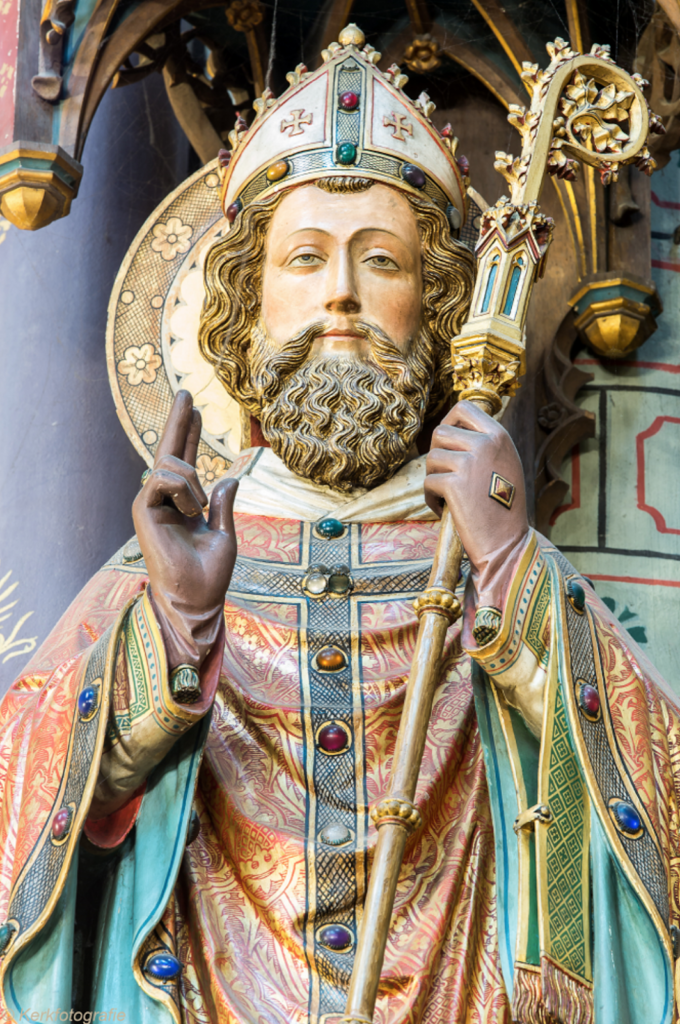
Image source taken from the Liturgical Arts Journal
Much of the material below is taken from Catholicireland.net and supplemented by quoted sources.
A synthetic overview
St Willibrord (AD 658-739) bishop, missionary and patron of the Benelux region. Willibrord, an Anglo Saxon from Northumbria in present day UK, was trained abroad in Ireland and ordained a priest while there. Just like St. Patrick, Ireland left her influence on the the saint to be. From Reverend Willibrord’s priestly ordination in the emerald isle, he was to bring Ireland’s influence to the continent, as one of the first missionaries to the Netherlands and Luxemburg.
His formative years
Willibrord received his Catholic education from a very young age. He had St Wilfrid in Ripon, Yorkshire as his teacher and guide. Now Wilfrid, was a leading light at the Synod of Whitby, A.D. 664, promoting the roman rite over Celtic liturgical traditions. Willibrord was professed at fifteen and in 678 he was sent to Rath Melsigi in Ireland for further studies and formation. Rath Melsigi was an important monastic settlement for the Anglo-Saxons. Historians long thought that Willibrord’s monastery was situated at Mellifont in Co. Louth. But historian, Prof. Dáibhí Ó Cróinín has located Rath Melsigi on the site of Clonmelsh, in Carlow. Ó Cróinín, wrote about Willibrord in 1982 and has published many papers on Rath Melsigi, and Willibrord in a published work ”In Peritia” chapter 3 (1984), pp. 17–49. After twelve years Willibrord was ordained priest in Ireland in 690, and he then immediately returned to England.
Missionary priest
After some time, Willibrord set out for Iona in Scotland, to promote the use of the Roman rite over Celtic traditions. From there, with a band of monks they all went to Frisia which is in present day Netherlands. In Frisia they were well received by Pepin of Herstal, duke and prince of the Franks. Before he began his mission in Frisia, Willibrord went to Rome to obtain approval from Pope Sergius I, for his mission and to procure some relics for the future new churches to be founded. Willibrord’s mission was a success and in 695, with Pepin’s recommendation, he was consecrated in Rome as the archbishop of the Frisians.
A new monastic centre at Echternach
In 701 Willibrord established a new missionary monastery at Echternach in Luxemburg. He did this with the help of some monks from Ireland. This centre became an important library and scriptorium in the Frankish empire. Willibrord died from fatigue in his early eighties at his monastery at Echternach. He became venerated as a saint and pilgrims came to his grave. An annual hop dancing procession takes place in Echternach on Whit Tuesday to honour St. Willibrord. Prof. Dáibhí Ó Cróinín, believes there is a connection (through St. Willibrord) between Irish and Echternach manuscripts and also a connection between the hop dancing procession and Irish dancing. It seems St, Willibrord modified the ”Céile” custom in Ireland at his Benelux pastures.
The church universal celebrates St. Willibrord on the 7th of November. He is particularly mentioned in the Irish liturgical calendar.